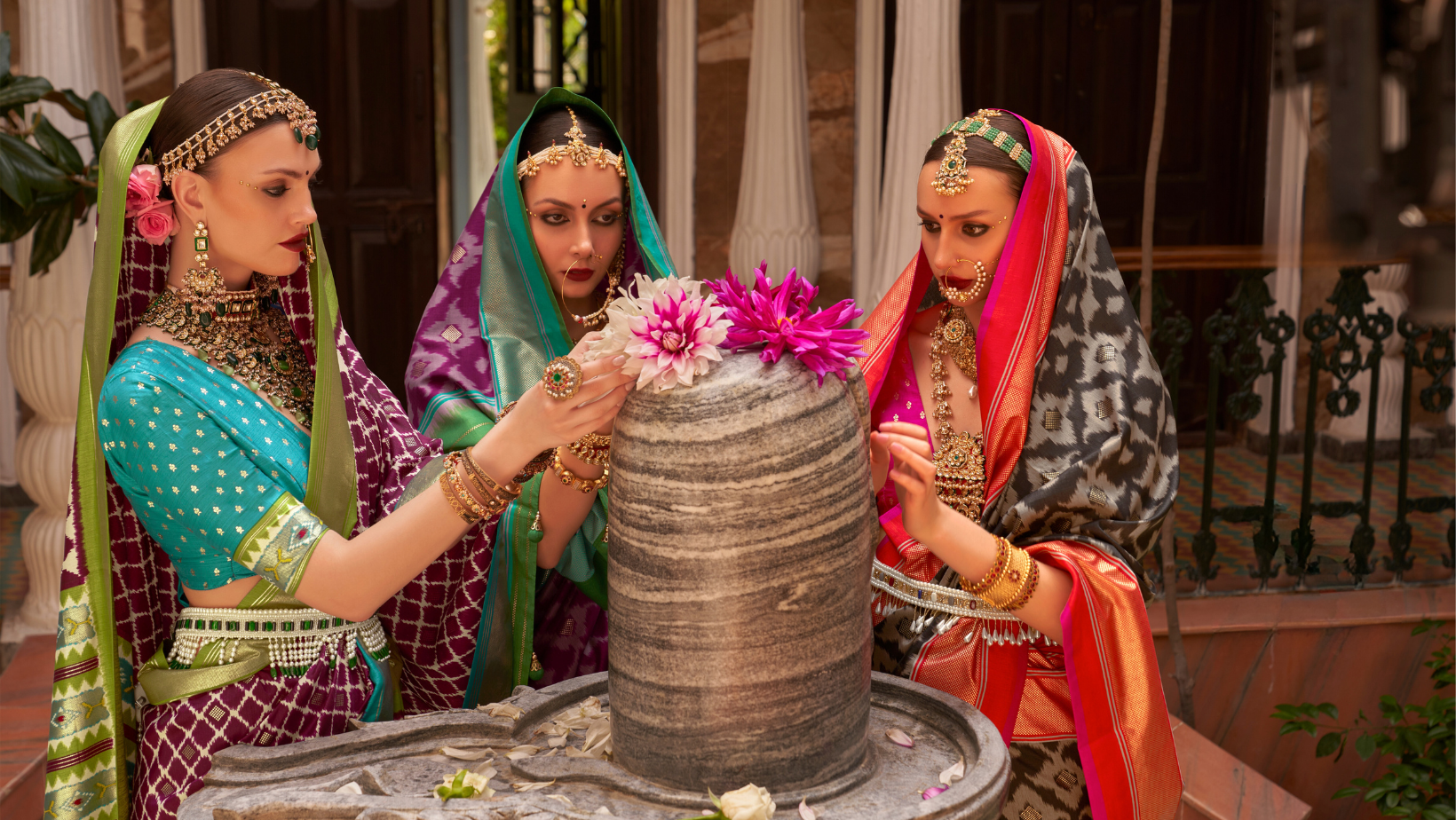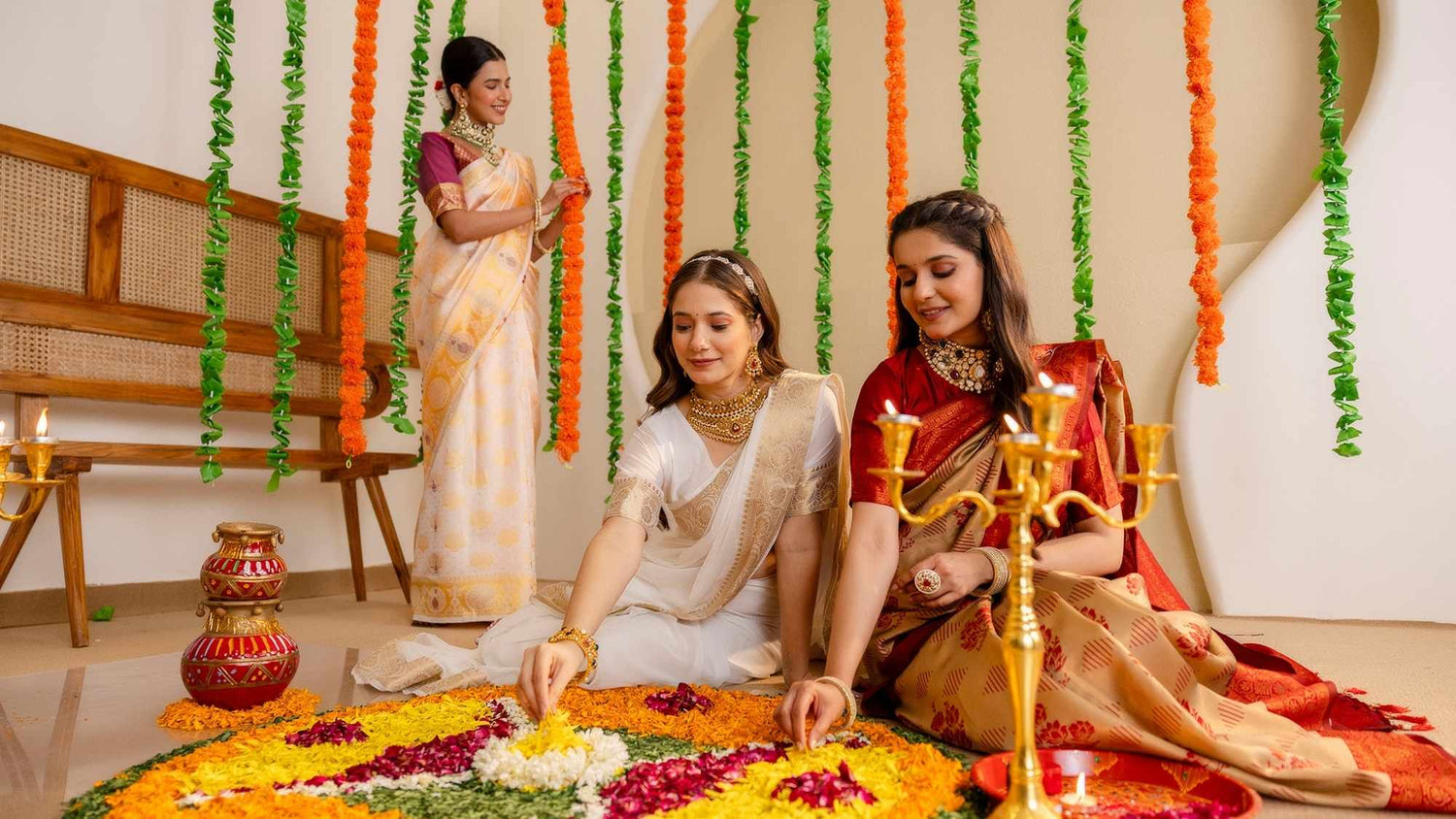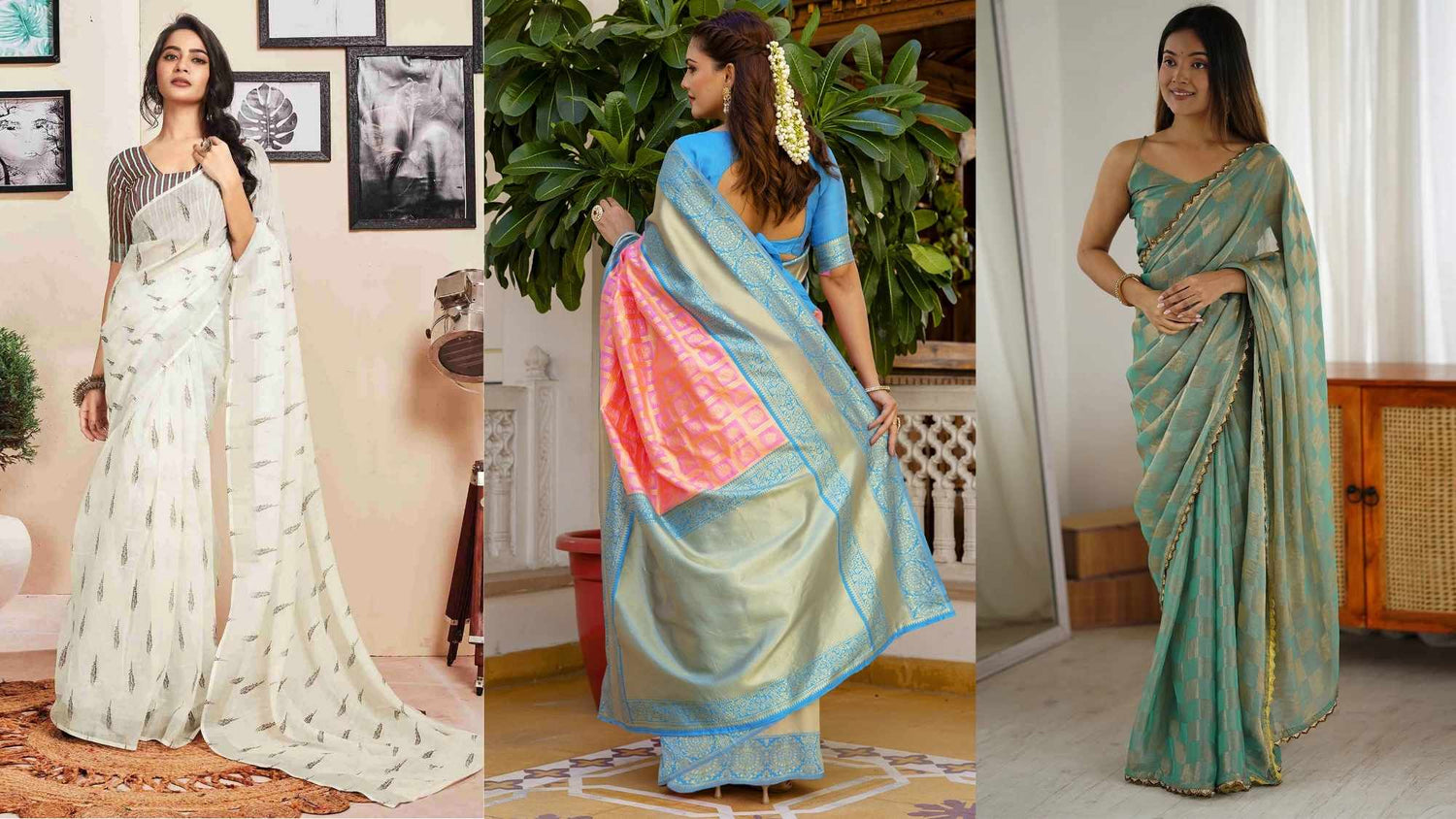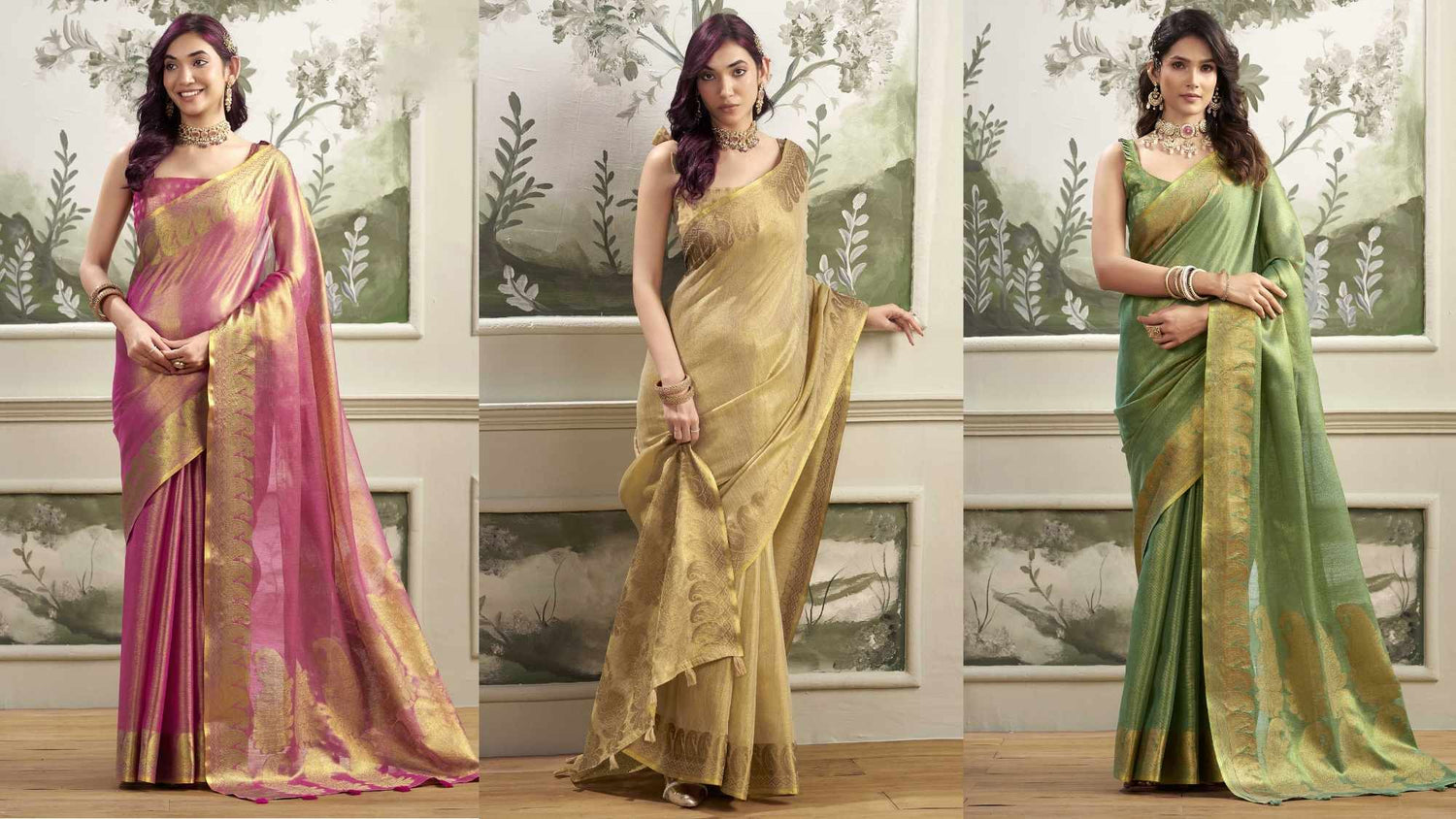India is the most diverse country in the world, and so are our sarees. "Sarees of India" have been part of our daily wear since the beginning of time. It is worn by Indian women in many different ways all around India as per state. Every culture has their own style and special pattern which gives touch to cultural heritage.
Every drape and style has its own uniqueness. Starting from the length of the saree to its weave, everything is different as per region they belong to. Some of them are made specifically of particular drapes only whereas in common it’s a six-yard piece of fabric that can be draped in quite different ways.
In this blog we will explore 12 types of sarees from India that showcase the rich heritage and timeless elegance.
1) Kanjeevaram: The Woven Legacy of Tamil Nadu
Kanjeevaram sarees, is one of the famous sarees of India. It is woven in the temple town of Kanchipuram, and is known for its interlocked weave that creates a geometric beauty. It is made up of pure mulberry silk and adorned with rich zari borders and motifs that narrate temples, mythology, or blooming flowers. These sarees are renowned for their timeless elegance and regal appearance, making them a popular choice for special occasions and celebrations.
2) Bandhani: Colours from Gujarat
Bandhani is a rainbow of colours with a saree! This Gujarati masterpiece uses tie-dye techniques to create tiny dots, geometric patterns, or paisleys. Vibrant colours on shimmering georgette or earthy elegance of cotton. These sarees originate from the colourful states of Rajasthan and Gujarat, where the art of Bandhani has been practised for centuries, passed down through generations of skilled artisans.
3) Paithani: Golden Grandeur from Maharashtra
Paithani sarees are a luxurious treasure sarees of India from Maharashtra, woven with pure silk threads in gold and silver, giving them a stunning shine. These sarees have beautifully designed borders and pallus with geometric patterns like "buttis" and "narali," all created on a handloom. Perfect for weddings and special events, Paithani sarees timeless elegance.
4) Nauvari: Unleash Your Inner Warrior Princess
The Nauvari saree, meaning "nine yards," is a special Maharashtrian drape that resembles a dhoti. It is made from colourful silks or soft cottons and is elegantly pleated at the back. This saree is secured with a unique blouse called a "kastha." Originally worn by Maratha women warriors for its comfort and flexibility, the Nauvari saree now symbolizes strength, empowerment, and cultural pride. It is a bold and meaningful attire choice for women celebrating their heritage with a touch of fierceness.
5) Ikat: Magic in Every Thread
The process in making Ikat saree involves carefully tying and dyeing the threads to produce geometric designs, floral motifs inspired by temples in Odisha. Ikat sarees are truly mesmerising. These sarees originate from the state of Odisha and feature a unique weaving technique that creates captivating patterns directly on the threads before they are woven into the fabric planning and the weaver's exceptional skill result in a one-of-a-kind saree that is a true work of art.
Owning an Ikat saree is like possessing a piece of history, a garment that showcases the incredible artistry of the Odisha region. These sarees of India are truly mesmerising beauty that are sure to leave a lasting impression.
6) Chanderi: Light as Air Luxury
Chanderi sarees from Madhya Pradesh, are known for it’s zari work that adorns the borders and pallu (the draped end of the saree). The zari, made from fine gold or silver threads, adds a touch of regal elegance to the saree. Additionally, some Chanderi sarees feature delicate buta (floral) motifs woven directly into the fabric, further enhancing the saree's visual appeal. It begins with the high-quality silk and cotton yarns, which are then carefully dyed in vibrant hues. The weavers then arrange the warp and threads on their traditional pit looms, skillfully incorporating the zari work and buta designs as they go.
These sarees of India are known for their exceptionally light and airy texture, making them a perfect choice for the warm summer months or any occasion that calls for effortless grace. Chanderi sarees, comes from the town of Chanderi in Madhya Pradesh, offer a truly unique and luxurious experience.
7) Kasavu: The Serene Beauty of Kerala
Kasavu sarees hold a special place in Kerala's culture, often worn during festivals like Onam. These sarees of India are made from pure white cotton with shiny gold borders, representing purity and prosperity, making these sarees a symbol of tradition and heritage in Kerala. Keep an eye out for the detailed "kari" work, which is a special gold border that adds a touch of elegance. Attention to detail in creating Kasavu sarees reflect the rich weaving traditions of the region.
8) Banarasi: A Jewel-Toned Masterpiece
Banarasi sarees originated from the holy city of Varanasi, Uttar Pradesh . Banarasi saree-making process involves the edges of the saree being carefully trimmed and the fabric is pressed to ensure a smooth, polished look. In some cases, the saree may be further embellished with embroidery, sequins, or beads, adding an extra touch of elegance and individuality.Whether worn for a special occasion or cherished as a family, a Banarasi saree is a skill, dedication, and artistry of the weavers who create these timeless masterpieces.
9) Pochampally: The Tie-Dye Magic
Pochampally sarees from Telangana are famous for their rich colors, patterns, and cultural significance. Pochampally sarees from Telangana are like a colorful celebration on fabric. They use tie-dye techniques to create vibrant hues and geometric patterns on pure silk or cotton. These sarees often feature the "ikat" technique, adding depth to their design. These sarees of India are usually worn at weddings, cultural events, and festive celebrations by Indian women.
10) Sambalpuri: The Intricate Weaves
Sambalpuri sarees from Odisha are a true reflection of the state's rich textile heritage. These sarees are woven from fine cotton or silk using a special technique called "Bandha," which creates intricate geometric patterns in vibrant colors. The unique "Ikat" patterns on Sambalpuri sarees often feature designs inspired by temples, nature, and geometric shapes, adding a touch of elegance and tradition to this stunning attire. These sarees not only showcase craftsmanship but also celebrate the cultural legacy of Odisha's weaving traditions.
11) Kantha: The Art of Storytelling
Imagine wrapping yourself in a saree that tells a story - a story of artistry, and the rich cultural heritage of West Bengal. This is the essence of the Kantha saree, a unique and cultural garment that has its roots in the rural communities of the region.The process of creating a Kantha saree is a labor of love. It begins with the careful selection of the fabrics, which are often salvaged from old saris, dhotis, or even discarded clothing.
These fabrics are then layered and stitched together, creating a sturdy and versatile base for the embroidery. When you wear a Kantha saree you are wrapping yourself in a narrative that spans generations, a narrative that celebrates the beauty of repurposing, the power of creativity, and the enduring legacy of a rich and vibrant culture.
12) Kota Doria: The Art Silk Saree
Kota Doria Sarees originate from Kota, Rajasthan, renowned for their blend of cotton and silk yarns, creating a lightweight yet durable fabric perfect for Rajasthan's climate. Their transparent weave offers breathability, while intricate zari borders add elegance with geometric or floral motifs. Available in a spectrum of colors, Kota Doria sarees are favored for their timeless appeal, comfort, and versatility, suitable for both casual and formal wear, making them a treasured addition to any wardrobe.
Conclusion
Now that you've explored a diverse world of sarees of India, it's time to make them yours.Sudathi offers a stunning collection of sarees, whether you fancy the regal Kanjeevaram or the vibrant Bandhani. With Sudathi, you'll find the perfect saree to elevate your style and celebrate the rich traditions of India.
Explore our range today and adorn yourself in elegance and craftsmanship like never before!







